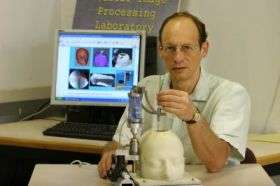Miniature robot for precise positioning and targeting in neurosurgery wins award

While recent advances in neurosurgery have made it possible to precisely target areas in the brain with minimum invasiveness -- using a small hole to insert a probe, needle or catheter -- there remains a disadvantage. The small size of the openings reduces or eliminates direct site visibility and requires greater dexterity, stability and precision by the surgeon.
Now, an invention by a Hebrew University of Jerusalem researcher has made it possible to retain the advances of such keyhole surgery through utilization of the “services” of a tiny robot that can guide surgical procedures with great accuracy.
For this development, Prof. Leo Joskowicz of the School of Engineering and Computer Science at the Hebrew University has been named one of this year’s winners of a Kaye Innovation Award, to be presented on June 6 during the Hebrew University’s 70th Board of Governors meeting. Prof. Joskowicz is the founder of the Computer-Aided Surgery and Medical Image Processing Laboratory at the Hebrew University, which he heads to this day.
Although keyhole brain surgery, based on preoperative CT or MRI images, has obvious advantages for the patient, misplacement of the surgical instrument in these procedures may result in hemorrhage and severe neurological complications.
To overcome this problem, Prof. Joskowicz and his associates have developed a novel, image-guided system for precise, automatic targeting of structures inside the brain. The system is based on a miniature robot that can be programmed with detailed information obtained from preoperative electronic scans of the patient.
During surgery, the robot is directly affixed to a head clamp or to the patient's skull. It automatically positions itself with great accuracy in respect to the surgical targets. Once positioned, the robot locks itself in place and serves as a guide for insertion by the surgeon of a needle, probe, or catheter to carry out the procedure.
Source: The Hebrew University of Jerusalem




















